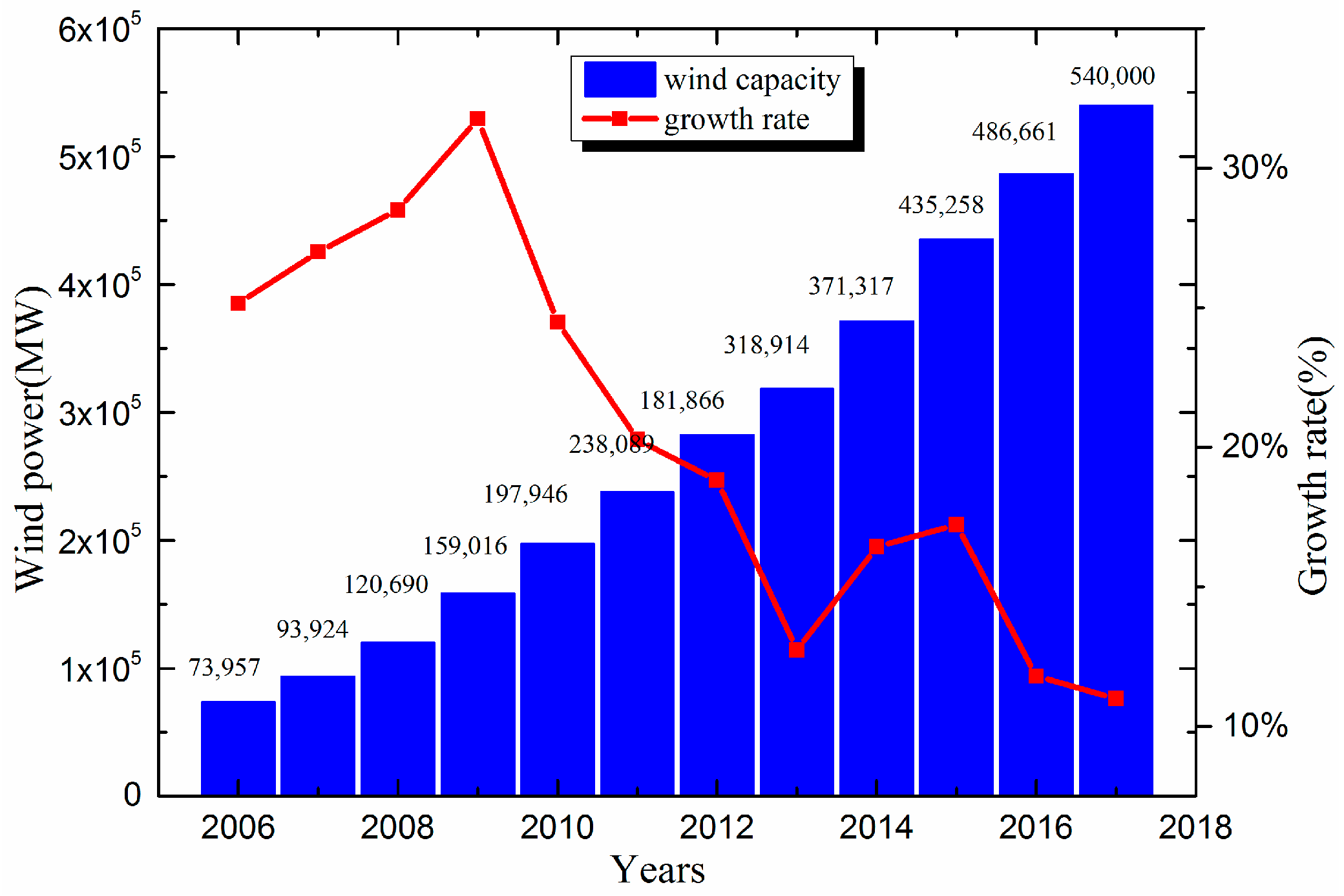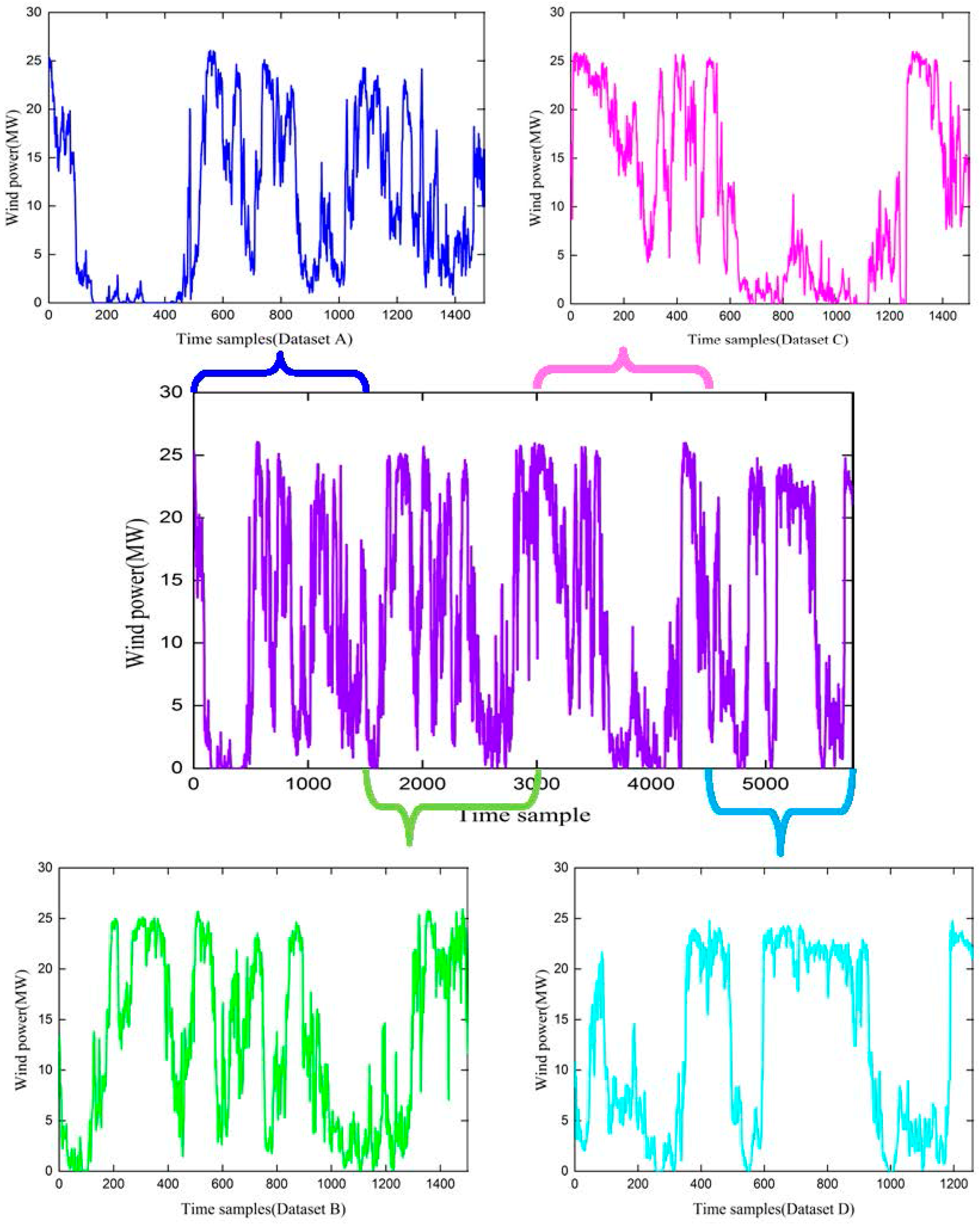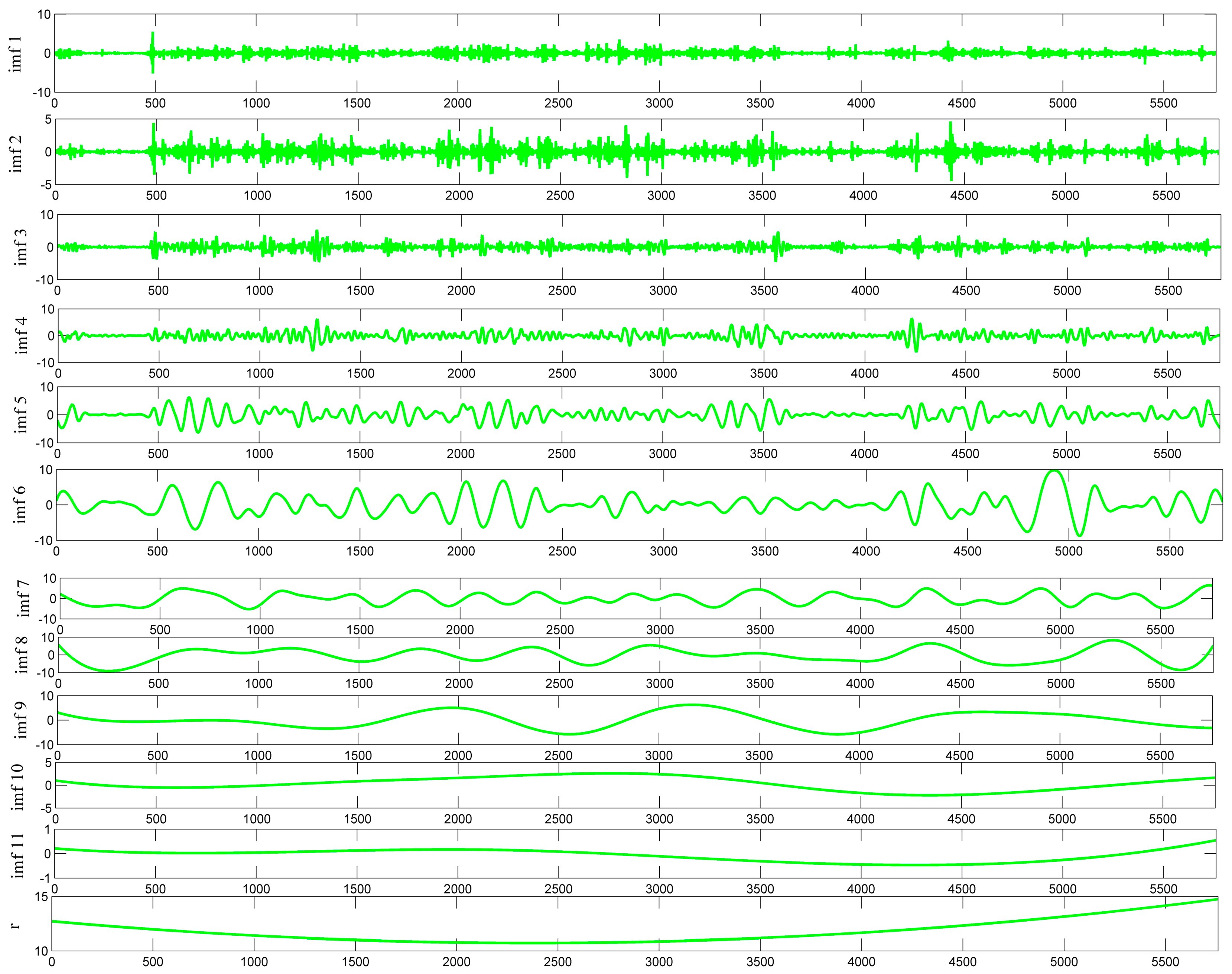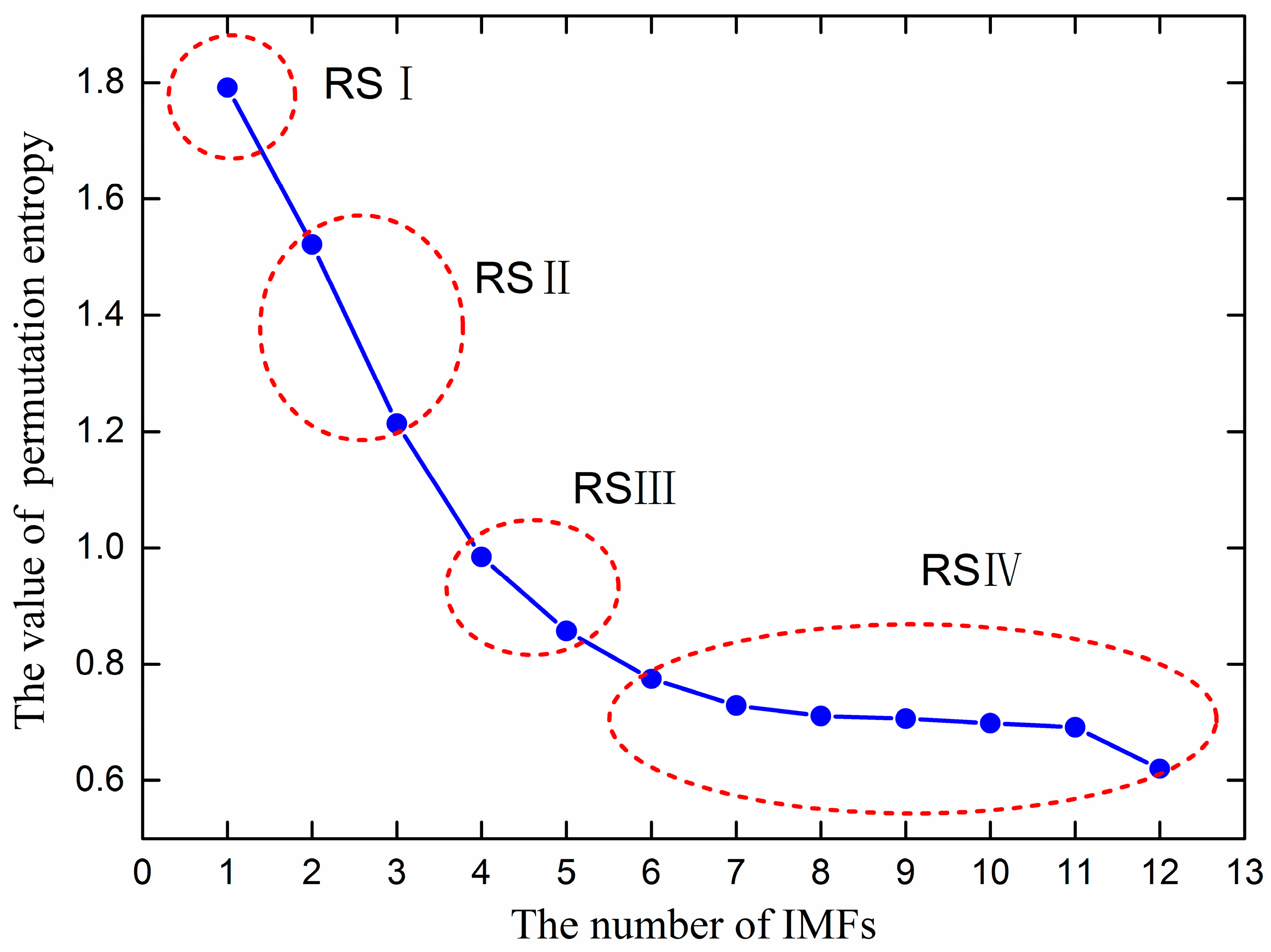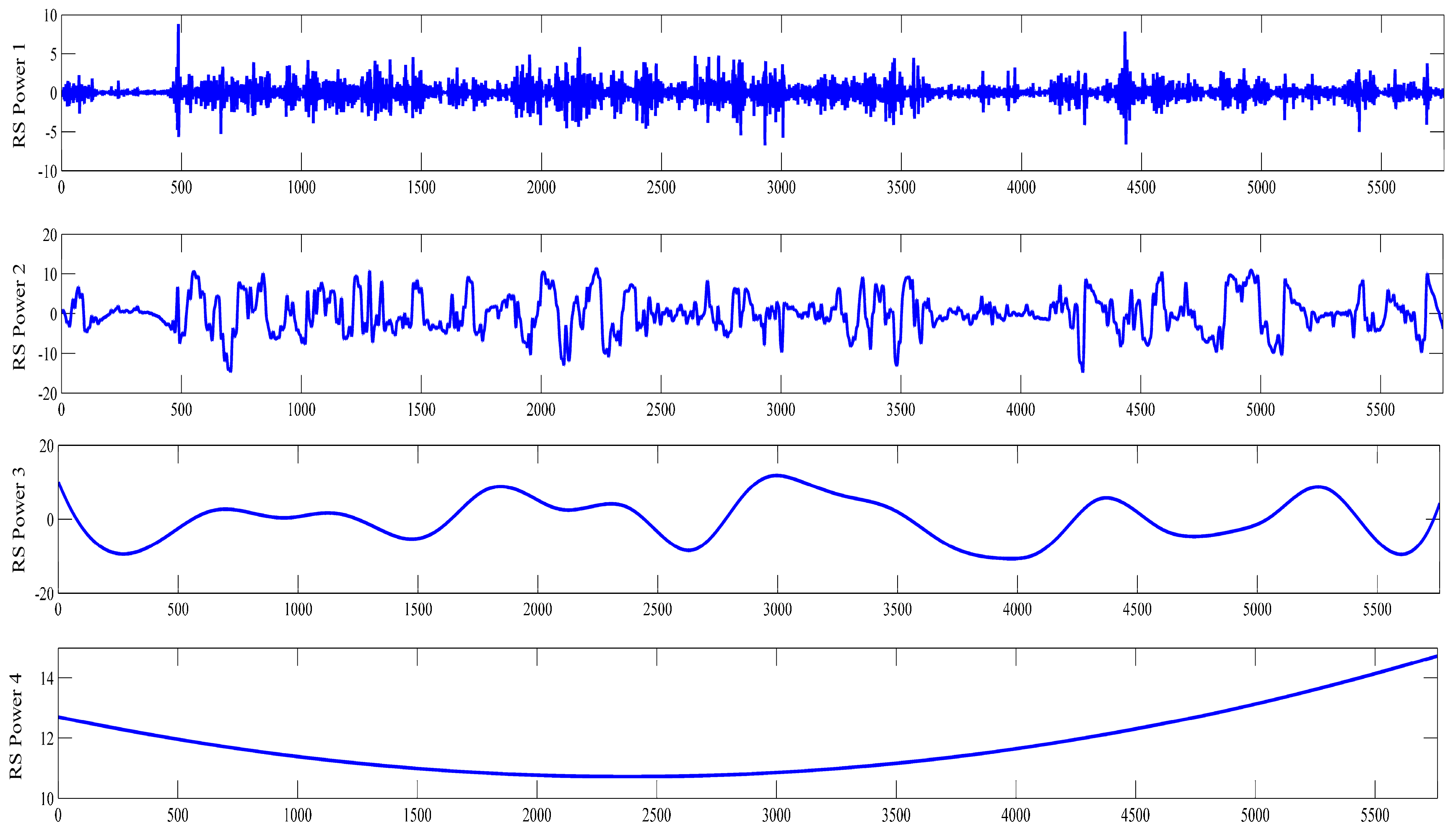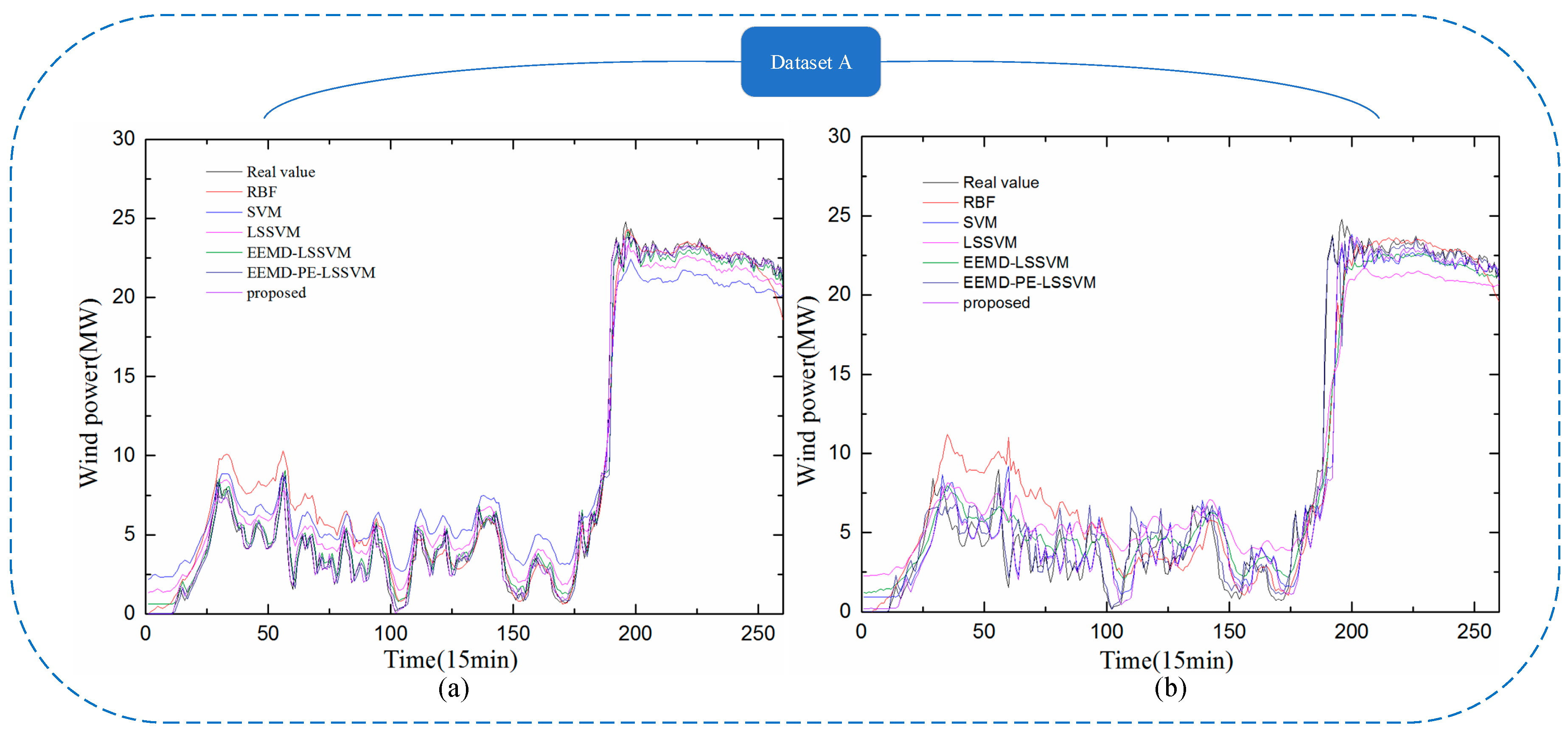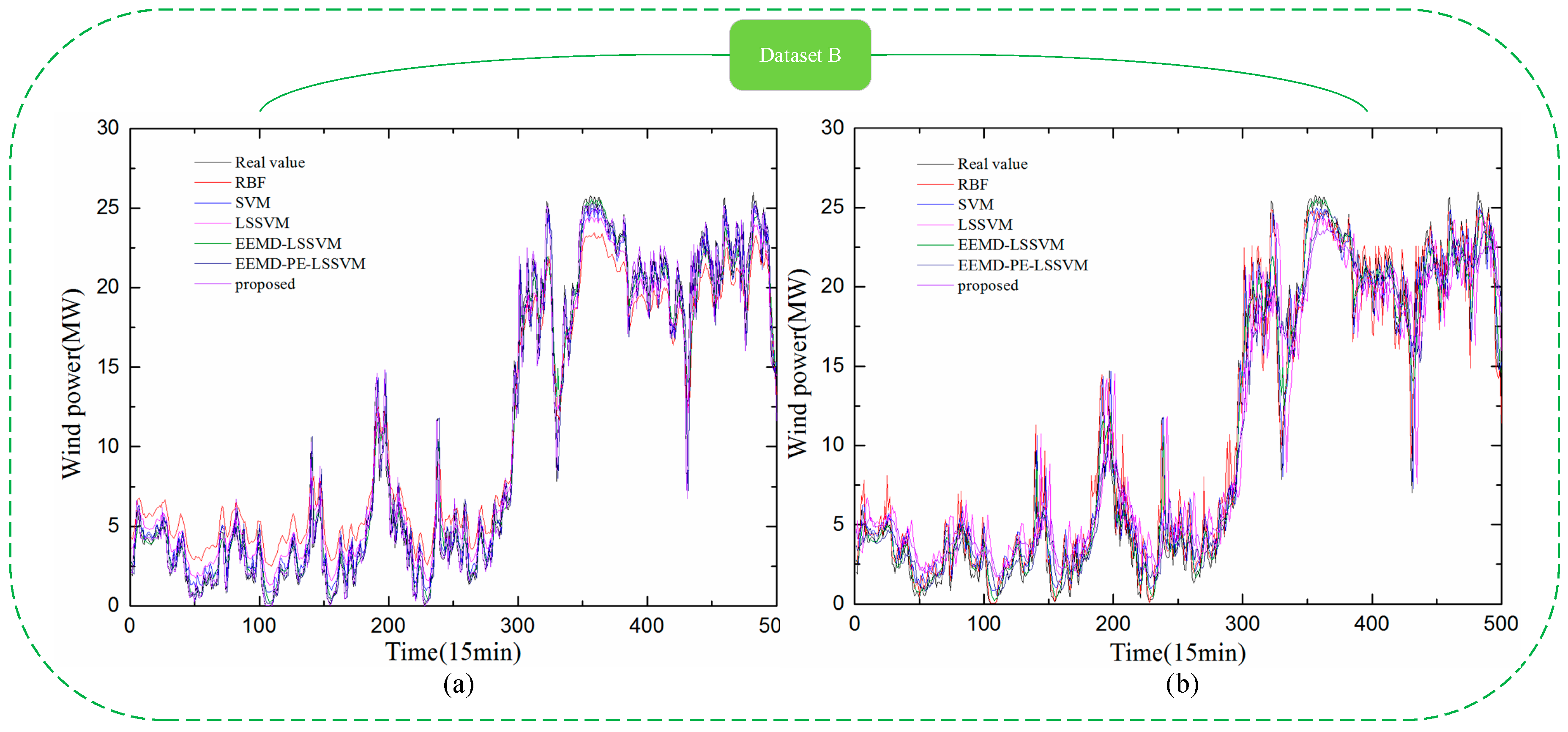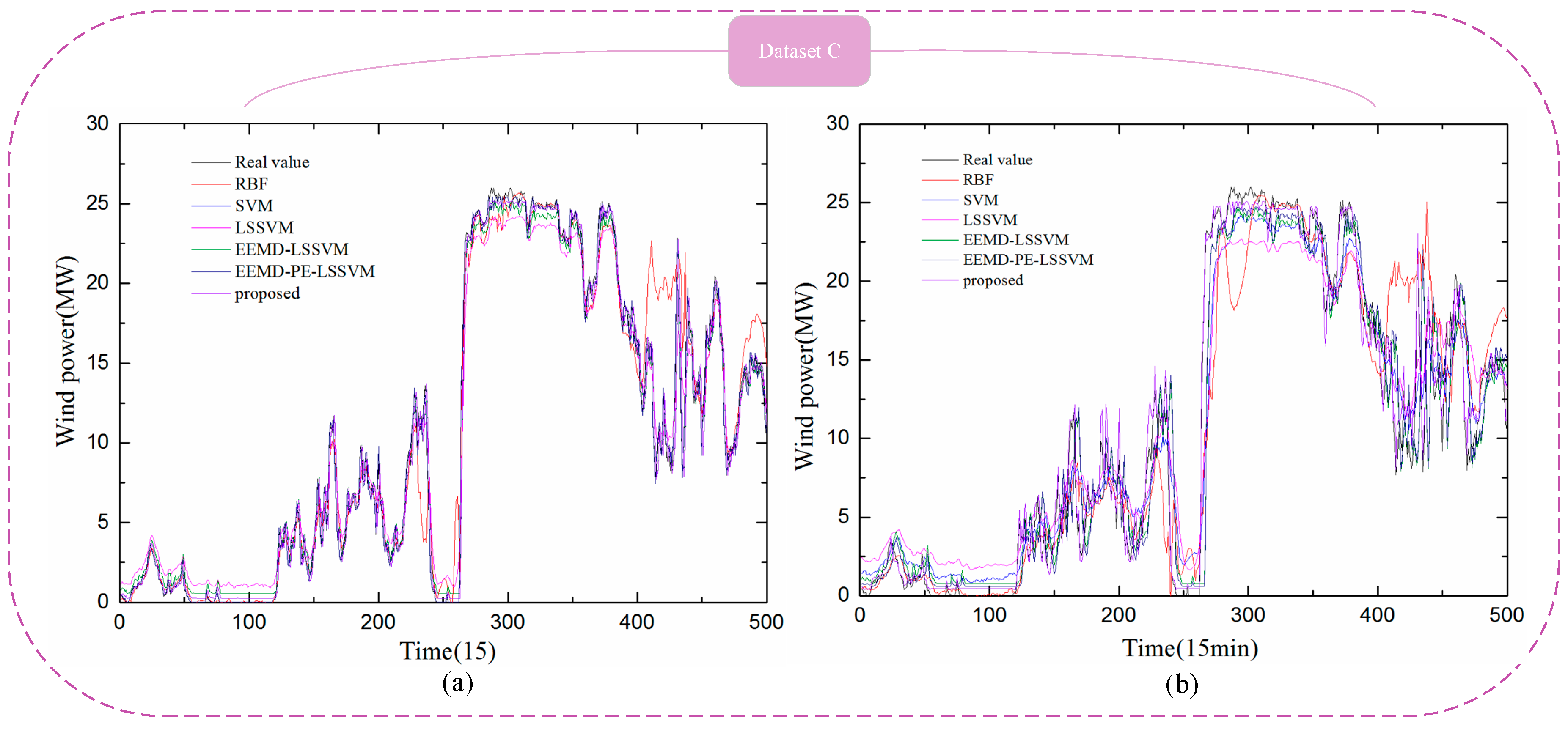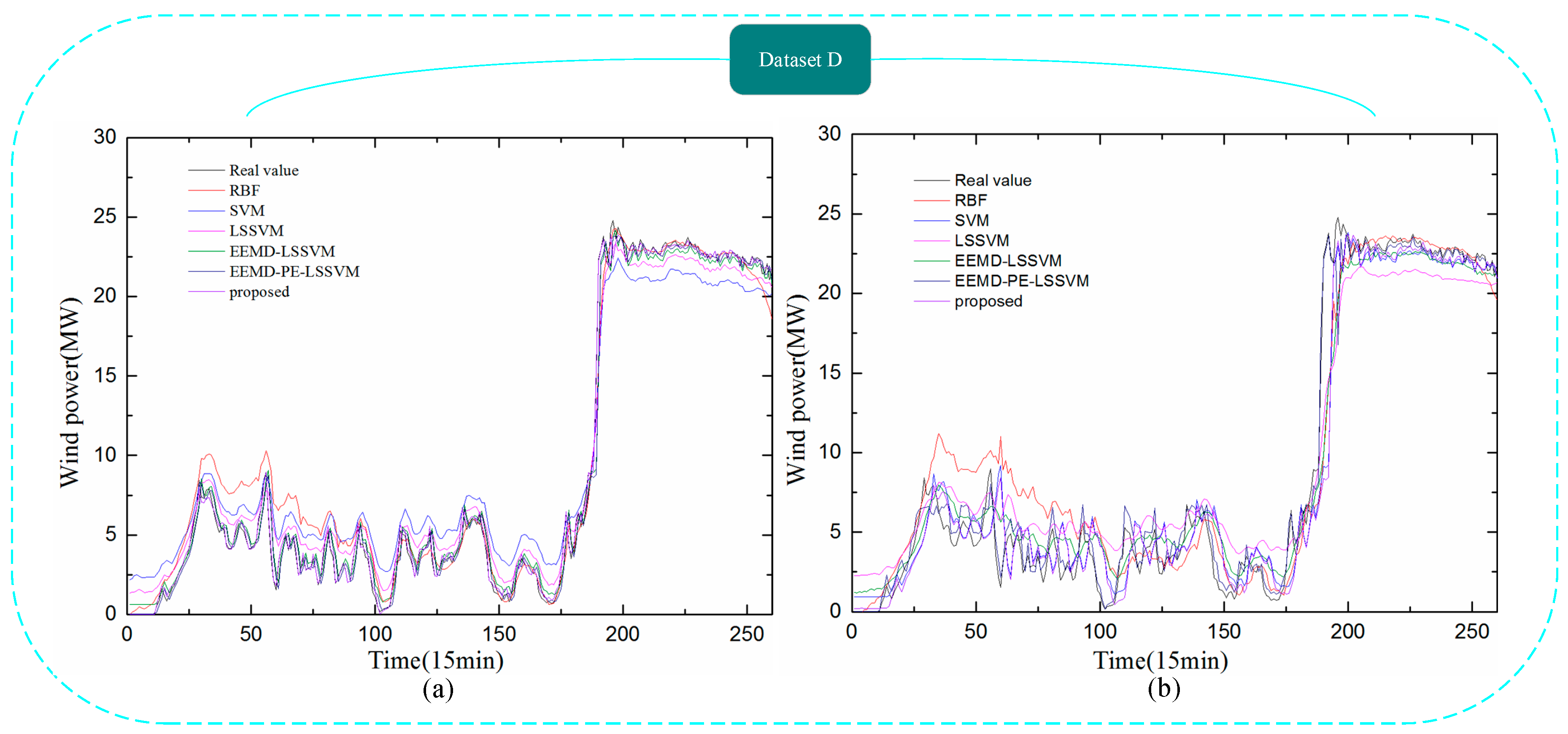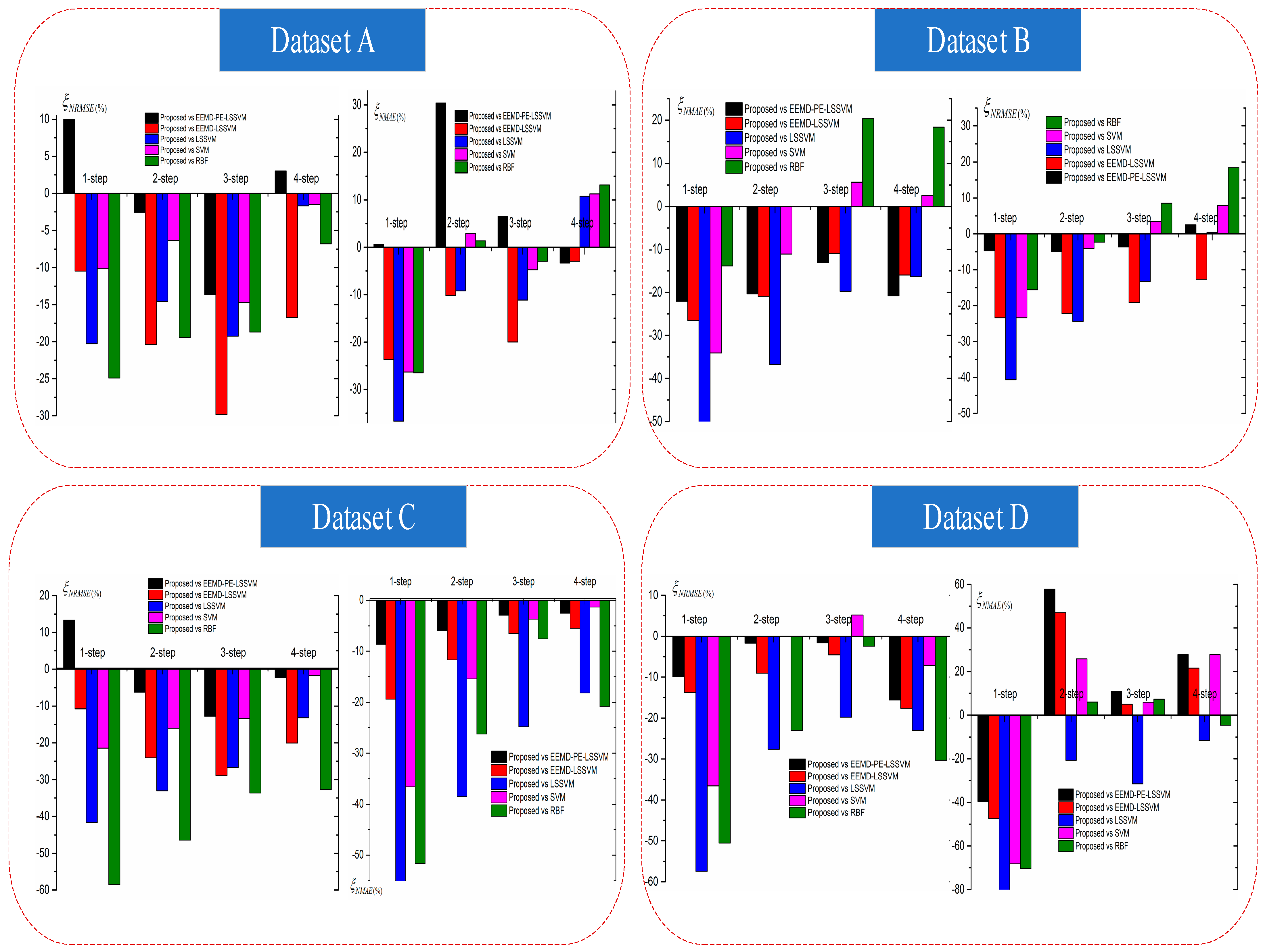1. Introduction
As a clean renewable energy, wind energy is regarded as a good alternative to deal with environmental problems and energy crises [
1,
2]. According to a report published by the World Wind Energy Association (WWEA), worldwide wind capacity reached 54 GW by the end of 2017, with a growth rate of 11.8% [
3]. The total installed capacity is reported in
Figure 1. The intermittent nature of wind power generation has posed a big challenge for maximizing the utilization of the wind power industry [
4]. It is of practical significance to optimize the wind power prediction algorithm and make it more suitable for the operation and wind conditions of a specific wind farm.
Wind power forecasting is difficult to achieve due to its intermittency and stochastic fluctuation, which brings great challenges to power system operation and control [
5,
6]. Over the past few decades, a large amount of research has been devoted to the development of effective and reliable wind speed/power forecasting methods, models, and tools [
7]. Generally, these methods can be broadly divided into four major models [
8,
9,
10,
11]: (a) physical models, (b) statistical models, (c) hybrid models, and (d) spatial correlation models. Physical models take into account parameters such as topography, temperature, and pressure, at the location of the wind farm, which are often utilized in short-term forecasting 6–72 h ahead and long-term forecasting with multiple weather variables. Typical physical wind power forecasting systems, among others, are the Prediktor system, developed by the Risoe National Laboratory in Denmark [
12]; Previento, developed by the University of Oldenburg in Germany [
13]; and eWind, developed by AWS True Wind Inc. (New York, NY, USA) [
14]. Statistical models are built based on historical power/speed time series data, which establishes a functional relationship between historical data and forecast data [
15]. These models analyze the relationship between various explanatory variables and online measurements. The well-known pure statistical models are the autoregressive (AR) model [
16], autoregressive moving average (ARMA) model [
17], autoregressive integrated moving average (ARIMA) model [
18], seasonal autoregressive integrated moving average (SARIMA) model [
19], and the autoregressive integrated moving average with exogenous variables (ARMAX) model [
20]. However, statistical models based on the assumption that linear structures exist among time series data cannot capture non-linear patterns very well.
Individual models lack the ability to deal with big data and fail to capture the majority of the complex characteristics of the original wind power series data [
21]. To make use of the advantages of statistical and physical models, a number of hybrid models with data pre-processing techniques, error post-processing techniques, and parameter selection and optimization techniques, have been proposed.
Data pre-processing techniques involve analyzing and processing data make original time series into multiple sequences or matrices, which have more obvious characteristics. Therefore, to some extent, pre-processing techniques can improve forecasting accuracy. Wavelet decomposition [
22,
23,
24,
25,
26] and empirical mode decomposition [
27,
28,
29] are the prevailing data pre-processing techniques, which can analyze the original wind power series in time and frequency domains. De et al. [
25] compared the hybrid artificial neural networks (ANN) method. Case studies show that wavelet decomposition (WD)-LSSVM performs better than WD-ANN. Zhang et al. [
29] used variational mode decomposition (VMD) to process original wind power series, then established a novel combined model based on machine learning methods. Zhao et al. [
30] analyzed the characteristics of the outliers caused by wind curtailment, then, a data-driven outlier elimination approach, combining quartile method and density-based clustering method was proposed; however, variational mode decomposition (VMD) is prone to mode mixing problems. Niu et al. [
31] used empirical mode decomposition (EMD) to decompose original wind speed data, then, a novel hybrid forecasting model based on the general regression neural network (GRNN) method, optimized by the fruit fly optimization algorithm (FOA), was proposed. Ye et al. [
32] discussed EMD, EEMD, complementary ensemble empirical mode decomposition (CEEMD), and complete empirical mode decomposition with adaptive noise (CEEMDAN). Their results showed that the proposed CEEMDAN-support vector regression (CEEMDAN-SVR) model out-performed the other models.
Error post-processing (EP-P) techniques use estimated error, which is obtained from a forecasting model, to correct final forecasting results. Huang et al. [
33] proposed a new, real-time decomposition model based on the feature selection and error correction of wind speed forecasting, which improved prediction accuracy. Platon et al. [
34] used an advanced technique to estimate surface wind gusts, then, combined dynamic and statistical techniques into the wind power forecasting model. Liang et al. [
35] improved wind speed forecasting performance using a correlation analysis method to analyze multi-step forecast errors and proposed a novel hybrid wind speed prediction model based on error forecast correction. Federica et al. [
36] employed a principal component analysis (PCA), combined with post-processing, to reduce computational costs and forecast errors. Li et al. [
37] proposed a new combined approach based on Extreme Learning Machine (ELM) and an error correction model, which improved prediction accuracy over a short-term time scale (6–72 h).
Parameter selection and optimization techniques can improve prediction accuracy and reduce prediction time through the training model. Xiao et al. [
38] employed a new hybrid prediction model based on a modified bat algorithm (BA) with the conjugate gradient (CG) method to multi-step wind speed prediction, which optimized the initial weights of the neural networks. Wang et al. [
39] proposed a novel combined forecasting model based on a multi-objective bat algorithm (MOBA), multi-step-ahead wind speed forecasting. Huang et al. [
40] proposed a novel forecasting model, using a quantum particle swarm optimization (PSO) algorithm, to receive higher forecast accuracy levels. Chang et al. [
41] compared the persistence method, the back propagation artificial neural network (BP) model, and radial basis neural network (RBF) model. Case studies showed that the proposed forecasting method was more accurate and reliable than the other three models. The clonal selection algorithm (CSA) [
42], gravitational search algorithm (GSA) [
43], particle swarm optimization (PSO) [
44,
45], simplified swarm optimization (SSO) [
46], and cuckoo search algorithm (CS) [
47], among others, are the prevailing methods to optimize the parameters of wind power/speed forecasting models.
Spatial correlation models characterize the relationship between the wind power or speed of a target wind farm and a reference wind farm at different spatial locations. Zhou et al. [
48] proposed a spatial and temporal correlation model and it was found that this model could improve ultra-short-term wind power forecasting accuracy. Tascikaraoglu et al. [
49] proposed a novel method, which first utilized a Wavelet Transform (WT) method to decompose the wind speed data into more stationary components and then used a spatio-temporal model on each of the subseries to incorporate both the temporal and spatial information for wind speed forecasting. Ye et al. [
50] analyzed uncertainty and dependence in wind power output, and employed a physical spatio-temporal correlation model. They found that this method outperformed statistical models.
In this paper, a novel combine model is proposed based on ensemble empirical mode decomposition, permutation entropy, least squares support vector machine, and gravitational search algorithm for ultra-short wind power forecasting. To investigate the effectiveness of the model, the proposed method will be thoroughly tested and benchmarked on real wind power data from Hebei, China. The main contributions of this research will be as follows:
- (1)
Using pre-processing techniques to deal with the complex wind power time series.
The ensemble empirical mode decomposition-permutation entropy will be used to analyze the original wind power series, by which the original wind power time series will be translated into some new, relatively stable subsequences. Ensemble empirical mode decomposition can decompose original wind power time series into a series of intrinsic mode functions (IMF) with different characteristic scales; however, it fails to capture weak changes in time series. Permutation entropy will be used to reconstitute subsequences by similar principles, which can promote weak time signals.
- (2)
Employing the LSSVM forecasting model, optimized by GSA.
LSSVM will be employed as the basic forecasting model, due to the features of regression for wind power prediction. To improve the forecasting accuracy and stability of LSSVM directly, the hyper-parameters of LSSVM will, firstly, be optimized by GSA to obtain the best hyper-parameters.
- (3)
Using comprehensive error metrics to assess the performance of the proposed model.
The error indicators, in this paper, will include the normalized mean absolute of errors (NMAE), normalized root mean square error (NRMSE), and Pearson correlation coefficient (R). In this paper, we will also introduce two improvement percentage error indexes, and .
The remainder of the paper will be organized as follows: the details of the proposed hybrid model based on EMD-PE-LSSVM-GSA for wind power forecasting will be illustrated in
Section 2. Forecasting performance evaluation indicators will be described in
Section 3. Experimental examples will be presented in
Section 4. The resulting analysis and forecasting performance of the proposed method, compared with other methods, will be given in
Section 5. Finally, conclusions will be given in
Section 6.
2. Proposed Methodology
The approaches used, including ensemble empirical mode decomposition, permutation entropy, the least squares support vector machine model, and gravity search algorithm, are described in this section. The EEMD-PE-LSSVM-GSA wind power prediction process is shown in
Figure 2.
2.1. Ensemble Empirical Mode Decomposition (EEMD)
EMD is frequently subject to a mode mixing problem, where a portion of the IMF may have properties that are quite similar to adjacent IMFs. EEMD is based on EMD and is an algorithm-based method of processing signals, which can be used to developed to solve the mode mixing problem [
51]. White noise is added to the wind power time series at different scales. In order to solve the EMD mode mixing problem, a detailed explication is given in [
52], as follows:
- (1)
Add white noise series to the original wind power series:
where
is the original wind power series, and
is the white noise series. Then, find the corresponding EMD components.
- (2)
Find the local maxima and minima of .
- (3)
Find the upper envelope and lower envelope .
- (4)
Calculate the mean of the wind power time series with white noise and the difference between
and
.
- (5)
Repeat Steps 1–3 with
instead of
, until
(where
is the acceptable error). Then, take
as the first EMD component of
, and the residual is as follows:
- (6)
The wind power time series
can be decomposed as follows:
where
represents the IMFs, and
is the final residue.
2.2. Permutation Entropy (PE)
In the case of nonlinear analysis, the complexity of the signal can be effectively determined according to its entropy values [
53], such as scale entropy, sample entropy, and multi-scale entropy. Permutation entropy is widely used in sequence complexity and nonlinear analysis because of its high robustness, efficiency, and simplicity.
This method’s motivation is the classification of the complex system. The larger the permutation entropy value, the higher the time series randomness of the sequence and the more likely another pattern will occur. Conversely, the smaller the permutation entropy value, the lower the time series randomness of the subsequence and the less likely another pattern will occur. The algorithm implementation process of PE is given below.
For
time series samples,
, the time series are reconstructed by
m-dimension phase space.
where
is the embed dimension of the wind power time series, and
is the delay time.
where
represents the index number of the column in which each element in the reconstruction vector resides. Each vector can be mapped to a set of symbols.
where
We calculated the probability of occurrence for each symbol sequence,
, where:
In the form of Shannon entropy, the permutation entropy of the wind power time series can be expressed as:
When
,
reaches the maximum
, the standardized processing can be achieved by:
Permutation entropy values were used to evaluate the complexity of each IMFs signal, and the adjacent entropy values were used to reconstitute IMFs into new subsequences (RS).
2.3. Least Squares Support Vector Machine (LSSVM)
The support vector machine (SVM) is an effective machine algorithm for data classification and regression [
54]. SVM can overcome data over-fitting problems and improve generalization performance by minimizing structural risk instead of empirical risk. The standard SVM uses nonnegative errors in the cost function and inequality constraints, while the LSSVM uses square errors and equality constraints. Therefore, LSSVM is a variation of the standard SVM.
Considering the wind power training dataset,
,
is the number of training datasets,
is the input vector,
is the corresponding output, and
is the dimension of
. The optimal decision function can be constructed by mapping the input space into the high-dimension feature space as follows:
where
is the nonlinear function,
is the weight, and
is the bias.
where
is the model complexity,
is the regularization parameter to balance the complex degree and approximation accuracy of the model, and
is the empirical risk function. The objective function of LSSVM can be framed:
where
represents the Lagrange multipliers.
Based on the Karush-Kuhn-Tucker (KKT) conditions, Equation (15) is given by:
Based on Equation (15) the following expression can be derived:
where
is a
dimensional vector,
is the coefficient matrix,
is the output matrix,
, and
is the kernel function on the basis of Mercer’s condition. The regression function of the LSSVM model can be described as:
The radial basis function is selected as the kernel function, which is given as follows:
where
is the kernel parameter.
2.4. Gravitational Search Algorithm (GSA)
The GSA was first proposed in 2009 [
55] and is a population optimization algorithm based on the law of gravity and Newton’s second law. The algorithm searches for the optimal solution by moving the particle position of the population. That is, as the algorithm iterates, the particles move continuously in the search space by the gravitation between them.
Assuming that the optimization problem can be given in (14) and (15), the particle’s position is the solution. The position of particle
is defined as:
Step 1: Initialize the speed and position of random particles and calculate the fitness of each particle.
Step 2: Calculate the gravitational constant
and the inertia mass of each particle:
where
is the initial gravitational constant,
is the decay rate,
is the maximum generation, and
Step 3: Calculate the resultant particle force, which can be given as:
where
is gravitation with the particles
i and
j, with dimension,
d, at the
t generation;
is the passive gravitational mass related to particle
i;
is the small constant;
and
is the position of dimension,
d, of particles
i and
j at the
t generation;
is the Euclidean distance between particles
i and
j.
Step 4: Calculate accelerated speed. According to Newton’s second law, the acceleration is obtained as follows:
Step 5: Update speed and position:
where
is a random number with a uniform distribution [0,1].
Step 6: Check the termination condition. Terminate the optimization if the stopping criteria requirements are met, and, if not, repeat the procedure from step 2 to 5 until the termination condition requirements are met.
2.5. The Proposed Method for Wind Power Forecasting
The flowchart of the proposed hybrid model based on EEMD-PE-LSSVM-GSA is illustrated in
Figure 3.
Stage 1: EEMD process
To build an effective prediction model, the features of the original wind power datasets must be fully analyzed and considered. EEMD techniques can be used to decompose the original wind power time series, , into new, relatively stable subsequences,
Stage 2: PE process
PE techniques can be used to analyze the intrinsic mode signals, , and reconstitute subsequences by combination stacking, to give reconstituted subsequences, .
Stage 3: Optimize parameters in the LSSVM process
The LSSVM forecasting model can be employed to forecast the reconstituted subsequences, , and the RBF kernel functions can be chosen to initialize the LSSVM.
(1): Initialize: Setting the parameters of GSA, the particle number is L, gravitational constant is , attenuation rate is , and the dimensions of GSA are .
(2): Calculate: Calculate the fitness function
as follows:
where
is the real wind power value,
is the forecasting value, and
is the number of samples.
(3): Update: The states are updated as follows:
where
is the position of the particle,
is the speed of search, and
is a uniform random variable, with a value in the range of [0, 1].
(4): Selection: If the iteration reaches its maximum, or the reaches its minimum, the best hyper parameters ( and ) and corresponding kernel parameters can be found.
(5): Validation: Output wind power prediction values for every new subsequence. The wind power forecasting errors, in terms of different criteria, are computed to validate the method. The results are compared with that of other methods. The best parameters of the optimized model will be obtained.
Stage 4: Hybrid process
Combine all the reconstituted subsequences of forecasting results and output the final forecasting results.
